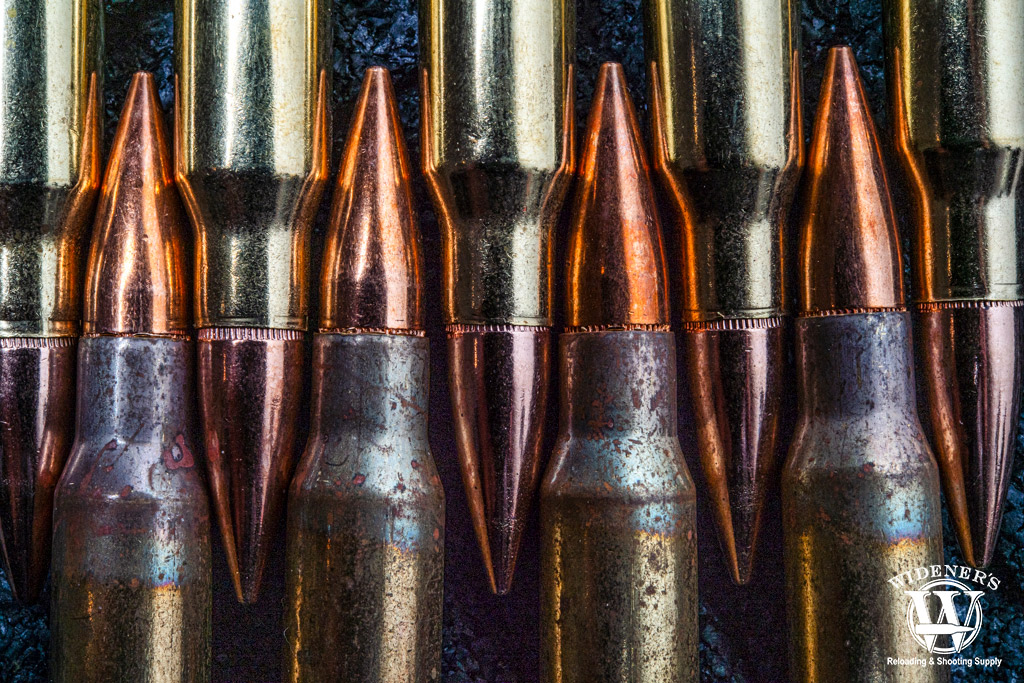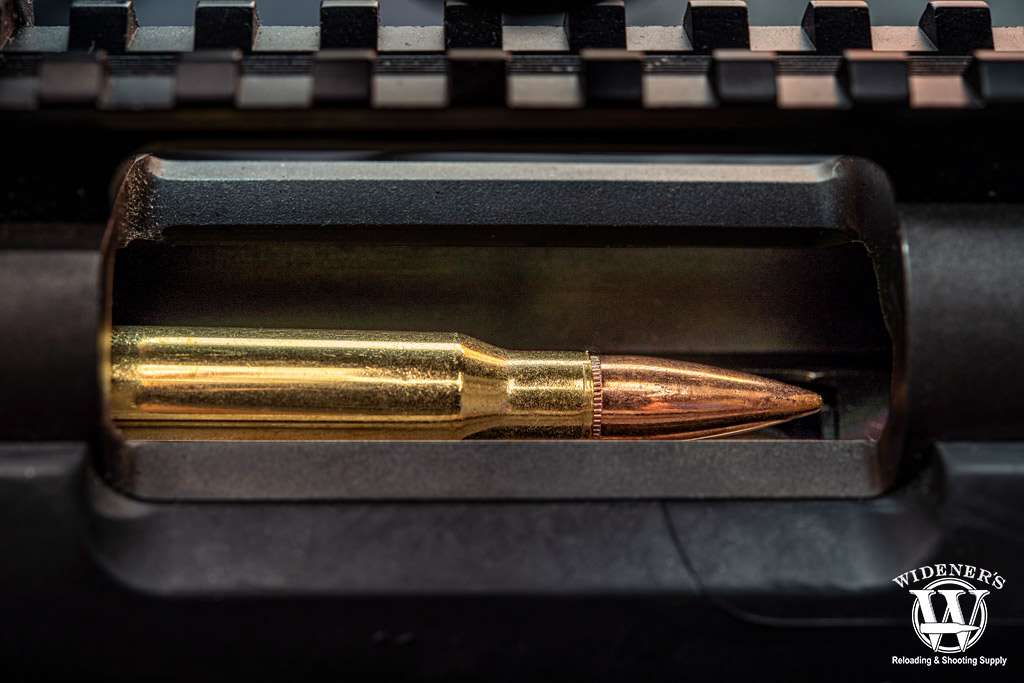

Comparing .308 vs 7.62 NATO is like describing twin brothers with different personalities – these rounds are almost identical in every way. Almost. Many people believe there is no difference between the .308 vs 7.62 NATO. However, it turns out there are several legitimate distinctions between these two rounds. Though small, these details can impact how you use the .308 and 7.62 NATO.
Generally, you can shoot 7.62 NATO in a .308 chamber, but you can’t always shoot a .308 round in a rifle chambered for 7.62. Understandably, this can be confusing, so we’ll walk through it step-by-step.
308 VS 7.62 NATO: What’s The Difference?

The cartridge dimensions between the .308 Win (Top), and the 7.62×51 NATO (Bottom) are identical.
Since these two rounds are identical in appearance, some might believe the .308 and the 7.62 NATO are the same round. Honestly, this isn’t completely wrong. However, the .308 and 7.62 do have technical differences. To understand these differences, we need to look at the origin and the purpose of these rounds.
Note: In this article, when we say the “7.62,” we are referring to the 7.62x51mm, also known as the 7.62 NATO. Do not confuse this round with the 7.62×39, the common AK-47 round. Or the 7.62x54r, a Russian rifle cartridge.
History Of The 7.62 NATO
During WW1 and WWII the formidable .30-06 was the military’s caliber of choice. However, there was some dissatisfaction with the low capacity of .30-06 rifles and the challenge of developing a smooth automatic platform.
To counter these issues, the 7.62x51mm cartridge began production in the early 1950s. Within a few years, the 7.62 NATO became the common caliber for military automatic weapons. It’s taken off since, and it’s one of the most popular rounds in the world.
History Of The .308 Winchester
The .308 is technically the civilian version of the 7.62 NATO. However, after only a few years it became preferred over the 7.62 NATO in the 1950s. The .308 was widely viewed as the perfect short-action variant of the 30-06, making it super versatile.
Hunters like the .308 for its big game power. Those looking for a self-defense option enjoy the .308 for the same reasons the military likes the 7.62 NATO – the combination of firepower and a smooth semi-automatic rifle.
Now for the gritty information. Let’s compare the main differences between these rounds.
Comparing The .308 VS 7.62 NATO

The .308 Win cartridge can withstand higher pressure (62,000 psi) than the 7.62 NATO (60,000 psi).
We’ve seen that the .308 and the 7.62 NATO are brothers, perhaps even identical twins, as some say. However, they do have slightly different attributes.
The differences between the .308 and the 7.62 NATO:
- Case thickness
- Cartridge Pressure
- Chamber size (and headspace)
Case Thickness
The first difference between the .308 and the 7.62 is the case thickness, with the 7.62 NATO running slightly thicker (the thickness varies by country of manufacture). This difference has an unnoticeable effect on the ballistic performance. However, the thickness of the case does relate to pressure control, as we’ll discuss in the next section.
Cartridge Pressure Compared

The civilian .308 Win design is a good balance of size, and weight, reaching velocities up to 3,500 FPS.
Though the .308 has a slightly thinner case than the 7.62 NATO, it generates slightly more pressure. The differences aren’t drastic, with the .308 generating anywhere from 2000-4000 (I’d try to use SAAMI for this if you can. Linking to another page that ranks for the same query we’re hoping to rank is probably not a great strategy.) more PSI than the 7.62 NATO.
Modern .308s rifles will have no problem firing 7.62 NATO. However, not all 7.62 NATO rifles should fire .308 Winchester. Why? The biggest reason to avoid placing a .308 in a 7.62 NATO comes down to headspace. We’ll talk about this in the next section.
Chamber Size (Headspace) Considerations

The military 7.62×51 NATO design is focused on consistency, and ballistic performance, reaching velocities up to about 3,200 FPS.
The slight difference in chamber size between the .308 and the 7.62 NATO is perhaps the most important variance. Why?
A 7.62 NATO rifle has a slightly longer headspace than rifles in .308. The reason for this extension comes down to several things. First, for automatic weapons, a longer chamber allows for easy cycling of the rifle. Second, due to the widespread production of 7.62 NATO, the lengthened chamber gives a little breathing room for differences between manufactured rounds.
The chamber size and headspace go hand-in-hand. The chamber is the area where the round sits before being fired. The headspace is the area (within the chamber) from the bolt to the shoulder of the round.
To visualize a rifle’s headspace, think about a glove. Just like a glove fits the human hand, the headspace fits around the case, seating it in place before the weapon is fired. If you’re curious, watch this video to learn more about headspace. Why is longer headspace a problem for .308 rounds? Let’s talk about it.
Can 7.62 NATO Headspace Be An Issue For .308?
With the thicker casing of the 7.62 NATO, there are no issues with a slightly larger headspace. However, you could run into issues when placing the thinner cased and higher pressured .308 into a 7.62 NATO chamber.
The headspace works with the casing to safely capture the pressure of the round. If the round isn’t snuggly fit within the chamber, there’s a risk the uncontrolled pressure could make the case split. This possibility of a ruptured case is why most shooters avoid shooting .308 ammo in a 7.62 NATO rifle.
Note: This is a bigger issue with older 7.62 NATO rifles. However, it’s worth having a professional check your rifle’s headspace before you start swapping rounds.
Identifying .308 VS 7.62 NATO

You can identify 308 (Left) VS 7.62×51 NATO (Right) ammo by the weight, head stamp, and unpolished annealing on the cases.
From the outside, the .308 and the 7.62×51 look identical. Visually, it would be difficult to tell them apart. If you weigh casings from .308 and 7.62 NATO rounds, you’ll find the 7.62 is slightly heavier (due to the relatively thicker case walls). Also, military NATO rounds like the M80 have unpolished annealing on the cases, making them easier to visually identify.
On a more practical level, some casings may have a headstamp that identifies the round – this is more common for civilian casings, like the .308.
Key Takeaway Comparing .308 vs. 7.62 NATO

You can safely shoot 7.62×51 NATO ammo in rifles chambered in .308 Win, check with your gunsmith before trying the opposite.
The .308 and the 7.62 NATO are very similar. However, the 7.62 NATO was designed for the military, and the .308 was instituted for the civilian market. There are ways to tell the two rounds apart, despite being identical in size.
Though you can safely shoot 7.62×51 through .308 rifles, it’s wise to have a gunsmith check the headspace in your 7.62 NATO rifle before using it to fire .308 rounds. Many rifles probably won’t have an issue. But, as they say, it’s better to be safe than sorry.
To learn more about .308 and 7.62 NATO, check out our article on the best .308 ammunition.


